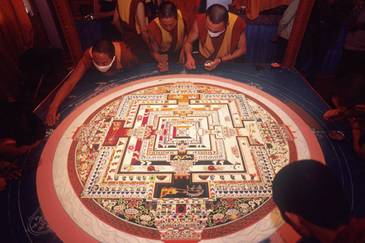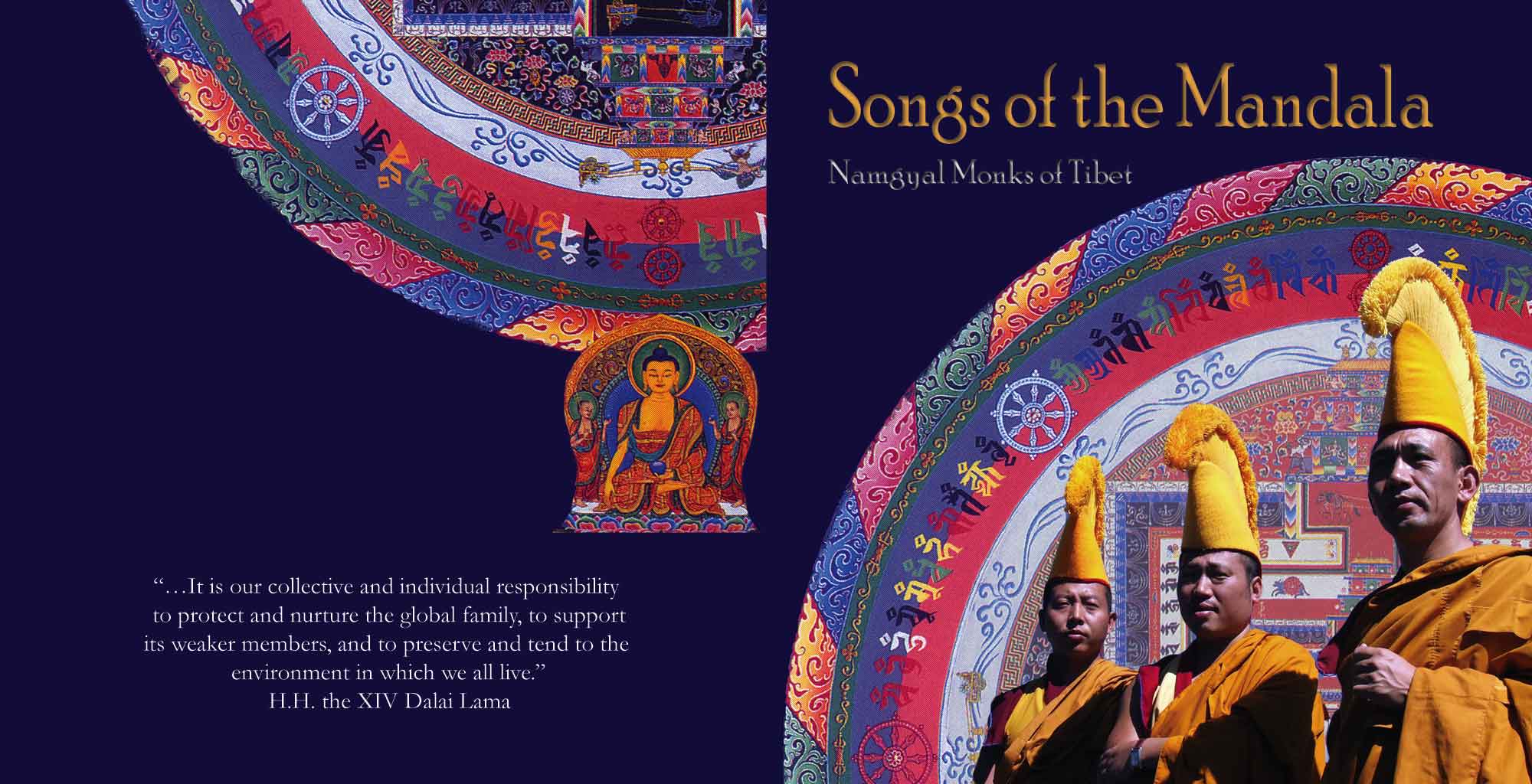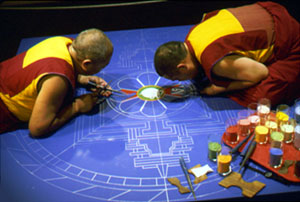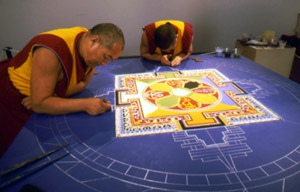
namgyal monks of tibet in exile
HISTORY
In 1575 Sonam Gyatso, the Third Dalai Lama, officially founded a monastery, which later came to be known as Namgyal Dratsang (Victorious Monastery). Since its inception, the monastery has assisted the Dalai Lamas in their public religious activities and performed ritual prayer ceremonies for the welfare of Tibet. From the beginning, the monastery has been a center of learning, contemplation and meditation on the vast and profound Buddhist treatises. Namgyal monastery is nonsectarian and maintains ritual practices and teachings of the four main lineages of Tibetan Buddhism.
IN EXILEAfter the Chinese invasion of Tibet and the 1959 popular uprising, His Holiness the Fourteenth Dalai Lama and one hundred thousand Tibetans fled to India and Nepal, among them 55 monks from Namgyal. Namgyal Monastery was re-established just outside the residence of His Holiness in Dharamsala, India, where the Namgyal artistic and intellectual traditions are being preserved and continued today. As it was in Tibet, the novice monks must first pass a series of challenging entrance examinations and, if accepted, undertake years of study. Namgyal is a tantric college; because it is the private monastery of His Holiness the Dalai Lama and the monks have less personal time, they require a more streamlined study program focusing on the essentials of sutra and tantra. In relation to these special requirements, His Holiness the XIV Dalai Lama has introduced many innovations, including a new syllabus and program of study, which is becoming a model for other Tibetan monasteries.
In addition to the intensive program of study of both sutra and tantra, students debate, and are instructed in the creation of sand mandalas and butter sculpture, ritual performance, music, chanting, dance and basic literary skills in Tibetan and English.
The program takes thirteen years to complete, at which time a "Master of Sutra and Tantra" degree, which is unique to Namgyal, is bestowed upon those who successfully pass the final examinations. Each monk must also complete a two to three month meditation retreat for each of the principal deities and protectors, in order to qualify to perform their rituals. The cycle of retreats might take up to six years to complete.
CULTURAL AMBASSADORS TO THE WEST
The opportunity to accompany the Dalai Lama on his visits abroad has enabled the Namgyal monks to participate in numerous presentations of Tibetan sacred art and dance in the United States, Europe and Japan. In the summer of 1988, monks from Namgyal Monastery created a sand mandala at the American Museum of Natural History in New York. Over 50,000 people came to watch this process during the six week demonstration. Historically, the creation of sacred sand mandalas was always carried out in secret but the Dalai Lama has now given permission for the public to witness these sacred arts.
In the summer of 1989, Namgyal monks assisted His Holiness with a Kalachakra initiation in Los Angeles. While one group of monks performed the preliminary rituals, including the creation of a sand mandala and the performance of two ritual dances, another group of four monks created a duplicate mandala at the Los Angeles Museum of Natural History. Since then Namgyal monks have created sand mandalas at other museums and galleries, including the San Francisco Asian Art Museum, the Herbert F. Johnson Museum of Art at Cornell University, the IBM Gallery in New York City, setting records for attendance at many locations.From all the artistic traditions of Tantric Buddhism, that of painting with colored sand ranks as one of the most unique and exquisite. In Tibetan this art is called dul-tson-kyil-khor, which literally means "mandala of colored powders." Millions of grains of sand are painstakingly laid into place on a flat platform over a period of days or weeks.
Formed of a traditional prescribed iconography that includes geometric shapes and a multitude of ancient spiritual symbols, the sand-painted mandala is used as a tool for re-consecrating the earth and its inhabitants.
The Monks of Namgyal Monastery have become especially well known for the creation of exquisite mandala exhibitions in museums and galleries throughout the world, as well as for other forms of sacred Tibetan arts lectures, and religious activities.

Mandala (kilkhor)
The Tibetan word for mandala is kilkhor, which means “center of the circle with exterior walls and surrounding environment.” A mandala is a visual prayer and also a symbolic universe. It may be represented by a three-dimensional model or more often two-dimensionally by means of a painted scroll. Mandalas may also be created with precious jewels, flowers, dyed rice, colored stones, or colored sand on a two-dimensional surface. Sand, traditionally made from ground precious stones, is considered the most efficacious material because of the precious substances involved and the great skill required to create the mandala’s exquisite details. Since each grain of sand is charged with the blessings of the ritual process, the entire sand mandala embodies a vast store of spiritual energy. According to Buddhist history, the purpose, meanings, and techniques involved in the spiritual art of sand mandala painting were taught by Sakyamuni Buddha in the 6th-century B.C. in India. This tradition has been preserved over the past 2500 years in an unbroken transmission from master to disciple.
Each mandala is a sacred mansion, the home of a particular deity, who symbolically represents and embodies enlightened qualities, such as compassion. In the Tibetan Buddhist tradition, mandalas are created for rituals of initiation in which a highly qualified teacher grants permission to advanced disciples to engage in the meditation practice of a particular tantric deity. Both the deity, which resides at the center of the mandala, and the mandala itself are recognized as pure expressions of a Buddha’s fully enlightened mind. Tibetan Buddhists believe that the seed of enlightenment in each person’s mind can be nourished by the dynamic process of visualizing and contemplating the symbolic meanings contained within a mandala. Through this practice, the initiate attempts to integrate these qualities and attain enlightenment for the benefit of all sentient beings. In Tibetan folklore, it is thought a great blessing just to see a well-made mandala, since the impression goes into the subconscious and marks it on the genetic level, so that in some time one will automatically gravitate toward the Buddha realm.
The Kalachakra Mandala is the most complex of all mandalas, housing the mandalas of Body, Speech, and Mind and representing a total of 722 deities. In the Kalachakra Mind Mandala, only the deities of the Mind Mandala reside. This is not to say that the latter is incomplete. Since the mind dominates body and speech, if one purifies or tames the mind, the body and speech will also be purified. That is why in Tibetan Buddhism, intention or motivation is more important than the physical actions of body and speech. The Kalachakra Mind Mandala represents the essence of the more elaborate Kalachakra Mandala
 |
|
